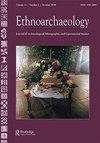Two Technological Traditions of Bifacial Points from the Breach Farm Site, Wales: An Interdisciplinary Analysis of Lithic Technology Integrating Experimental Replication, X-Ray Fluorescence, and Geometric Morphometry
IF 1.3
0 ARCHAEOLOGY
引用次数: 1
Abstract
ABSTRACT To accurately replicate highly complex, flaked stone artifacts using the same raw materials as the original artifacts is a challenge for any present-day flintknapper. Replication of individual bifacial points from a Bronze Age burial mound in Wales led to further study of the artifacts. Integrating experimental replication, technological analysis, x-ray fluorescence, and geometric morphometry, we conducted a study of the bifacial points from the Breach Farm site. Results revealed two technological traditions; the technological details of the production sequences; possible use of a source of Greensand chert in France as raw material on both shores of the English Channel; no evidence of practical use or post-depositional damage; and the considerable expertise of the flintknapper(s). This study suggests contact across the English Channel involving people from Armorica (France) by trade or tribute, and it supports interpretations of production of these artifacts for mortuary contexts rather than functional use as arrowpoints.来自威尔士裂口农场遗址的两种双面点的技术传统:集成实验复制,x射线荧光和几何形态计量学的Lithic技术的跨学科分析
使用与原始器物相同的原材料,精确地复制高度复杂的片状石质器物,对任何当今的燧石手来说都是一个挑战。在威尔士的一个青铜时代墓葬丘上复制的单个双面点导致了对这些文物的进一步研究。综合实验复制、技术分析、x射线荧光和几何形态测量,我们对裂口农场现场的双面点进行了研究。结果揭示了两种技术传统;生产流程的工艺细节;在英吉利海峡两岸可能使用法国的一种绿色燧石作为原料;没有实际使用或沉积后损坏的证据;和相当专业的燧石手。这项研究表明,跨越英吉利海峡的接触涉及来自法国的阿莫里卡(Armorica)的人们,他们通过贸易或贡品进行了接触,它支持了对这些文物生产的解释,这些文物是为了殡葬,而不是作为箭头的功能性用途。
本文章由计算机程序翻译,如有差异,请以英文原文为准。
求助全文
约1分钟内获得全文
求助全文
来源期刊

Ethnoarchaeology
ARCHAEOLOGY-
CiteScore
1.60
自引率
0.00%
发文量
10
期刊介绍:
Ethnoarchaeology, a cross-cultural peer-reviewed journal, focuses on the present position, impact of, and future prospects of ethnoarchaeological and experimental studies approaches to anthropological research. The primary goal of this journal is to provide practitioners with an intellectual platform to showcase and appraise current research and theoretical and methodological directions for the 21st century. Although there has been an exponential increase in ethnoarchaeological and experimental research in the past thirty years, there is little that unifies or defines our subdiscipline. Ethnoarchaeology addresses this need, exploring what distinguishes ethnoarchaeological and experimental approaches, what methods connect practitioners, and what unique suite of research attributes we contribute to the better understanding of the human condition. In addition to research articles, the journal publishes book and other media reviews, periodic theme issues, and position statements by noted scholars.
 求助内容:
求助内容: 应助结果提醒方式:
应助结果提醒方式:


